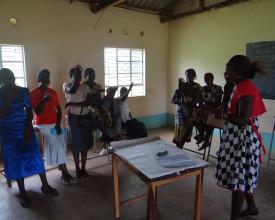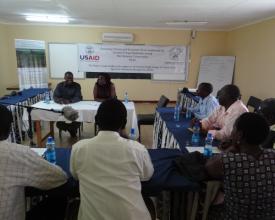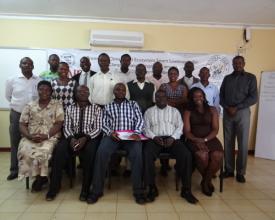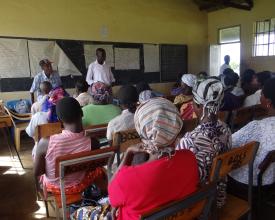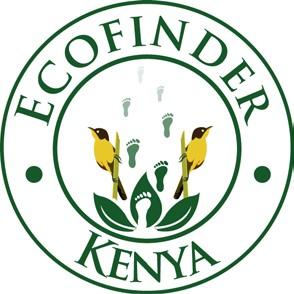
Ecosystem-friendly livelihoods for wetland-dependent communities in Kenya
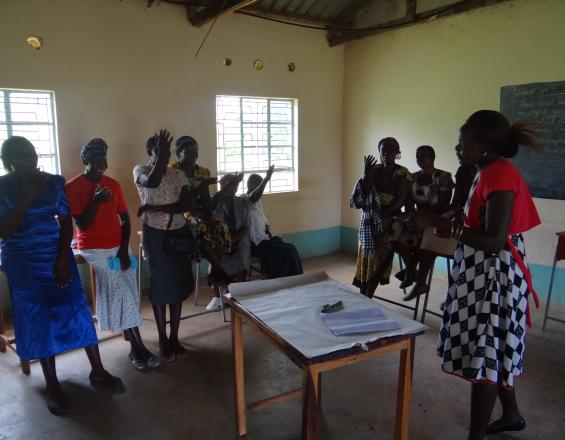
Yala wetland communities are dependent on the ecosystem goods and services offered by the wetland for their livelihoods; mainly small-holder subsistence agriculture. In the recent past, farmers have experienced reduced crop production human, an increase of wildlife conflicts, and continuous drought and floods are accelerating local poverty and food insecurity. In order to reverse some of these effects, we identified and piloted in a participatory process alternative livelihoods that are less wetland-destructive and environmentally friendly. These included agroforestry, sustainable farming and water harvesting techniques that would be sustainable under the changing climatic conditions.
Context
Challenges addressed
Environmental challenges:
The solution addresses continuous destruction of wetland vegetation through wetland encroachment and livelihood activities such as uncontrolled wetland farming, burning of papyrus vegetation, unsustainable papyrus harvesting, overgrazing on wetland areas during drought. Other challenges addressed include overfishing and human setllement on wetland habitats, sand harvesting along river banks and papyrus wetland areas and poaching.
Social challenges:
The solution also addresses food insecurity among the local people, human-wildlife conflicts and hunger.
Economic challenges:
The solution addresses poverty among the local people by promoting alternative livelihood activities that are sustainable and income generating.
Location
Process
Summary of the process
Stakeholders can be used to identify areas that need resilient and sustainable livelihood activities. Through stakeholder engagement, livelihoods and climate challenges are identified and potential solutions reached, leading to the development of a community-based action plan. The action plan can be adopted and sustainable livelihood options ranked.
Stakeholders identify the best places for learning and exchange.
Stakeholders are identified to attend the exchange visits and learn practically how livelihood resilience activities have worked elsewhere.
Exhange visits help stakeholders develop skills that are used locally to build up on sustainable activities that increase resilience with respect to agricultural production and biodiversity conservation.
Building Blocks
Stakeholders involvement and participation
This involves participation of all stakeholders at the local level in order to come up with locally viable solutions that all participants are comfortable with and that contribute to sustainable livelihoods and long term conservation of local biodiversity. We achieved this building block by involving stakeholders at different levels, i.e. at the meso or County level and micro or local community level. First, we engaged representatives of the Siaya County government departments (such as Agriculture, Lands, Tourism, Environment and Natural Resources) and Civil society representatives working at the local and regional levels. A workshop was organised upon which the government and non-government actors discussed the challenges facing agriculture and biodiversity in relation to climate chage in the County and amicable and potential solutions sought from the participants. Secondly, local level meetings were held with community members and local leaders and resource persons including elders, retired government staff, health workers and conservation enthusiasts. The challenges facing agriculture and local biodiversity were sought and potential solutions reached. These were then analysed to come up with overal challenges and solutions from the stakeholders perspective.
Enabling factors
- Analysis and involvement of critical stakeholders to make sure that all people with interest are involved. This should include (1) government departments at the County or District levels, (2) Non-state actors including Non-governmental Organisations (NGOs), Community-based Organisations (CBOs) and Faith-based Organisations (FBOs) among others, and local communities
- Recognition of the roles played by various stakeholders.
- Recognition of potential benefits and benefit sharing from the proceeds of conservation.
Lesson learned
- Stakeholder involvement at both meso or County/District level and micro/community level ensures potential for inclusion and use of results in local policy change
- Forums bringing government and non-state actors contribute to harmonisation of conflicting views and ideas and ensure potential for harmony in implementation of various strategies. However, we experienced many opposing views during strategy discussions pitting the government officers and the civil society.
- Potential for benefit sharing and incentives are critical for conservation of biodiversity at the local scale.
- Local communities are willing to participate in biodiversity conservation initiatives when alternative livelihoods can be provided.
Community exchange visits
Exchange visits were organized to places where the initiative has been active for some time and the implementation is on-going. For example, in order to acquire drought tolerant crops for local production, Ecofinder Kenya visited the Tangokona community in Busia County, Kenya where improved cassava and sweet potato varieties have been promoted and grown by local communities. The model was studied by Yala wetland communities, seeds purchased and farmers are now growing drought tolerant cassava and sweet potatoes.
Enabling factors
- Pay actual visit to model sites or farmers.
- Availability of resources including transportation, learning facilitation at the place of visit.
- Willingness to learn and practice the new skills among the interested stakeholders.
Lesson learned
- Local production of recommended drought resilient crop varieties can be achieved by learning and sharing of skills and ideas.
- Farmers can embrace and practice what they see and can confirm to have worked in similar places.
- The success of implementation of improved crop production and testing of new crop varieties may be dependent on prevaining weather conditions mainly rainfall amounts especially for rain-fed agriculture.
Community based action plans
Relevant stakeholders are engaged to identify challenges within their respective communities and solutions that are ecosystem friendly but contribute to the enhancement of local livelihoods. This process follows a prior participatory community-wide assessment and validation of results from the assessment or survey process. The assessment identifies livelihood and climatic trends and impacts on various sectors. Following this, a stakeholder meeting is initiated through which potential adaptation and sustainable livelihood stategies are proposed and adopted against each challenge and included in the overal community-based adaptation plan. A community-based action plan matrix is then generated through the stakeholder participatory process that includes the following sections: livelihood and adaptation options, duration of implementation, actors, required resources, key expected results and estimated amount to implement each adopted strategy or action.
Enabling factors
- Availability of adequate data or information collected through a participatory process using participatory instruments involving various stakeholders.
- Participatory involvement of both local and County-level stakeholders
Lesson learned
- Adequate involvement of stakeholders including community members can help collect data on baseline information.
- Community involvement from the beginning contributes to them accepting management planning results and their positive contribution towards implementation.
- Sharing the community based plan with local stakeholders and community members contribute to their ownership of the local-elevl generated action plans.
Impacts
- Three (3) community based climate adaptation action plans (CBAP) developed to guide implementation of challenges in wetland agricultural landscapes including human-wildlife conflicts, flooding and drought.
- Three (3) climate and ecosystem-friendly livelihoods identified: agroforestry, sustainable water harvesting and sustainable farming. Training manuals developed and used to train more than 90 community members in three (3) villages.
- New water well sunk in Nyadorera village to support small scale irrigation and provide watering point for community members during dry seasons directly benefiting ten (10) households and helping in reducing human-wildlife conflicts in Yala wetlands area.
- Woodlot established, water harvesting tank provided at Barolengo Sec. School to provide water for irrigating seedlings during dry spells.
- 500m2 agroforestry woodlot established as windbreak for protection (crop and buildings) against strong winds and to provide refuge for some local biodiversity. The woodlot also planted with multiple benefit trees (e.g. fruits, firewood, poles) for community use.
- Community well rehabilitated, secured by fencing providing water to 15 households during drought hence reducing human-wildlife conflicts
Beneficiaries
Local communities of all genders: women, youth and men
Sustainable Development Goals
Story
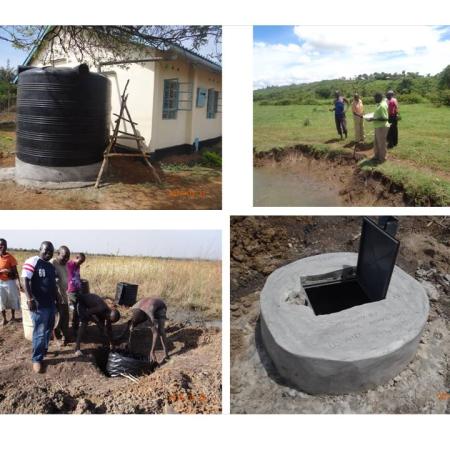
Wetlands in Lake Victoria and Kenya at large have been targeted for human and economic development by the local communities, who depend on them almost entirely as source of their livelihoods. I was raised up in such a family and my parents drew wetland resources such as fish, papyrus reeds, and were depending on the rich soil in the wetland areas for seasonal farming. However, the once productive Yala wetlands have been witnessing crop destruction from wild animals like wild pigs, prolonged drought periods and frequent flooding, all of which negatively affect the traditional livelihoods. During these periods, croplands are being destroyed, people have poor access to clean water for domestic and livestock use, and increasingly using inorganic fertilizers in farms close to the wetlands. This project has turned tables for the participating families and the water wells that used to run dry in the village have been rehabilitated to provide water for the families. The agroforestry woodlot is also providing a haven for small wildlife species e.g. mongoose, rats. mice etc. on land that used to lie fallow.The local Barolengo secondary school was provided with a water storage tank to water seedlings, which are planted by students in the compound during drought. The use of certified drought tolerant cassava and sweet potato crops have now been replicated by farmers locally to ensure food security among local households.
